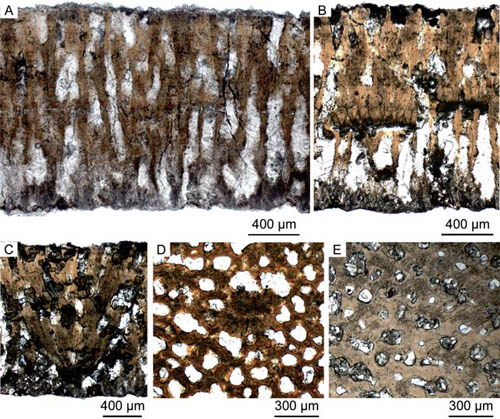Dinosaur egg clutches, single eggs, and countless eggshell fragments have been found in the the Upper Cretaceous of the Pingxiang Basin, Jiangxi Province of China since 2002. In an article published in the latest issue of
Vertebrata PalAsiatica 51(2), Dr. WANG Xiaolin, Institute of Vertebrate Paleontology and Paleoanthropology (IVPP), Chinese Academy of Sciences, and his team described a new oospecies:
Parafaveoloolithus pingxiangensis oosp. nov. This study helps better understanding the composition of the Pingxiang dinosaur eggs oofauna and provides new data to study the eggshell formation and evolution of the dinosaur eggs in the Cretaceous Period.
Parafaveoloolithus pingxiangensis is oblate in shape, and its outer surface is smooth. Its eggshell is usually composed of three or five superimposed slender shell units. In some portions, 6−10 shell units are assembled in the middle and upper part of the eggshell. Pores are straight and unbranching, extremely numerous, and closely spaced, looking as a whole like a honeycomb in tangential section through the middle part of the eggshell.
"Compared to the members of faveoloolithids, the new specimens should be assigned to the oogenus
Parafaveoloolithus on the basis of some shell units tending to assemble in the middle and upper part of the eggshell", said study coauthor Dr. WANG Qiang of the IVPP, “However, the difference is remarkable between the new specimen and the known oospecies,
Parafaveoloolithus microporus,
P. macroporus,
P. tiansicunensis and
P. guoqingsiensis, of which the eggshell usually has two or three shell units tending to assemble in the middle part of the eggshell. Therefore, the specimens described here represent a new oospecies”.
This work was supported by the National Natural Science Foundation of China, the National Science Fund for Distinguished Young Scholars, the National Key Basic Research Program of China, and the Key Laboratory of Evolutionary Systematics of Vertebrates, IVPP, CAS.

Fig. 1 Holotype of
Parafaveoloolithus pingxiangensis oosp. nov. (Image by ZOU Songlin)

Fig. 2 Eggshell microstracture of
Parafaveoloolithus pingxiangensis oosp. nov. (Image by ZOU Songlin)

